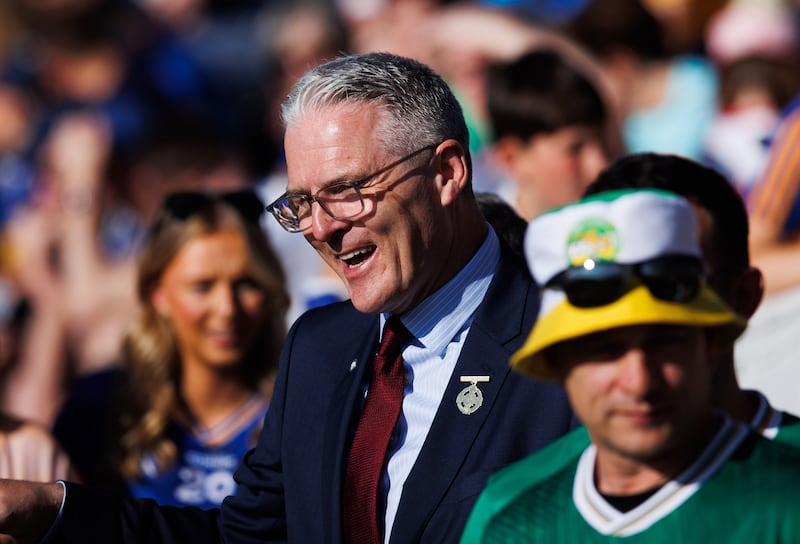The pessimistic update on the chances of Casement Park being ready for Euro 2028 that GAA President Jarlath Burns shared with us yesterday doesn’t really come as much of a surprise.
But it is still a bitter disappointment for those Ulster people who had held out hopes of a major sporting event coming to a town or a city near them.
Any Dubliner that I spoke to after the Europa League final, held in Lansdowne Road last month, had such a positive experience. It was not, as it turned out, Jurgen Klopp’s victorious farewell to Liverpool fans. It wasn’t Glasgow Rangers coming to town, with all the baggage that would have entailed.
It was two clubs, neither of which had ever won the European Cup/Champions League, or indeed had ever won a domestic league title (until Bayer Leverkusen won this season’s Bundesliga, of course), who had no prior support on this island. It was not a heavyweight contest, but it was a heavyweight event, and it felt like it on the night.
READ MORE
Euro 2028 was a chance for Belfast and the North to have multiple events of that size (five games in total), and it won’t now happen it seems. Maybe Keir Starmer has other ideas, but his in-tray will be lengthy – by the time Casement Park gets to his desk, it might already be too late as far as Uefa are concerned.
One of the less-widely reported lines from Burns’ comments to the press at the launch of the All-Ireland hurling championships on Tuesday was nevertheless telling.
“One of the things we’re going to have to do in order to get the number of people in is that we’re going to have to dig further down and take out maybe four or five metres to create more seating,” he said.
“That’s massive money to do that. That obviously wouldn’t have to be done now so it would take a lot less to build Casement to Ulster GAA final specification as opposed to European Championship specification.”

And that is not something to be disregarded lightly. It seemed to me that Burns was almost eager to move the argument on from the straight binary of whether Euro 2028 in Belfast is going to happen, on to the future of Casement Park beyond or outside the parameters of a continent-wide football tournament.
Casement Park as a 34,000, all-seater Uefa-standard stadium now seems unlikely. But a quick ‘no’ on the Euros from a new Labour-led UK government would at least allow the GAA in Ulster and nationwide to progress the project along lines drawn up by themselves.
And if (a big if) the new Casement Park must be smaller, then that’s no bad thing. Whatever new plans will be drawn up once the Euros question is answered definitively, the GAA absolutely should not press ahead with a 34,000-seater stadium.
This coming weekend is a vivid illustration of what size stadiums the GAA actually needs. Padraic Joyce was pushing to have Galway and Armagh, two teams in pretty much anyone’s top five nationally at the moment, play their final round-robin fixture in Croke Park. They will meet instead in Markievicz Park in Sligo town – with its capacity of just over 18,000. Their game last year was fixed for the slightly smaller Páirc Sean Mac Diarmada in Carrick-on-Shannon, to general uproar, but that game wasn’t even a sell-out in the end.
The GAA’s approach to stadiums is still build ‘em big, and don’t worry about the frills.
We will see if the GAA decide to give both this year’s All-Ireland hurling quarter-finals to Páirc Uí Chaoimh. If, as expected, the Cork hurlers beat Offaly this weekend, then that would mean a Dublin intercounty team being asked to play a far superior team in their home ground in a key end-of-year fixture. Any bellyaching from the Dublin County Board on that score would be rich, to say the least.
The GAA doesn’t need bigger stadiums, it needs better ones. And it needs to give these better stadiums plenty of games. If Casement Park ends up being a world-class sports ground and outdoor events arena with an all-seater capacity of 22 or 25,000, then that would be a net-positive result for the GAA, locally and nationally.
Jarlath Burns said this week that “the Gaelic Athletic Association will always be in a very precarious position when we find ourselves depending on the goodwill of the British government. It’s never worked out for us before”.
The GAA will still need money from the British government, funding long-promised to them after the redevelopment of Windsor Park and Ravenhill. It may fall short of the £60 million the Dundonald Ice Rink got in East Belfast, as Joe Brolly so hilariously pointed out a couple of months ago as Casement’s future started looking murky. But it will be enough to get the stadium built, to the GAA’s specifications. It seems to me Jarlath Burns is already busy imagining that new future for Casement Park.
















